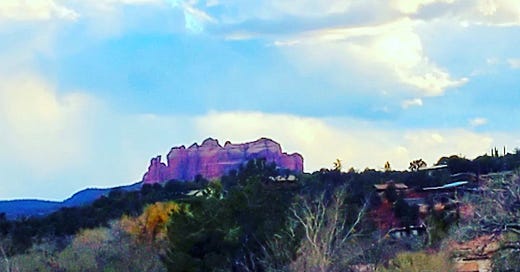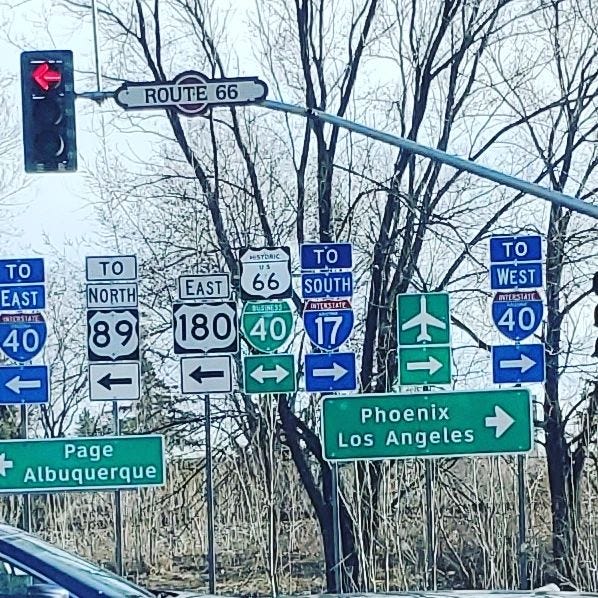We were standing in line at an overpriced cafe in Sedona when I saw a poster for a show that weekend. "OMG, John Ford Coley is playing here," I exclaimed. "I wish we could go!"
Isabelle was aghast. "What are you even talking about? You hate John Ford Coley."
I was kind of surprised she remembered that fact about me, but then, we've been friends for over thirty years now, and it's true. I DO hate John Ford Coley, because my friends in high school, long celebrated (by me, to her) for their shitty taste in music, loved him. "Well, maybe he's gotten better," I said defensively.
I didn't really think he had, though. And to be honest I’d have been disappointed if that were so. I just love seeing live music in goofy places and the thing about John Ford Coley is that he is the epitome of Sedona. I'd even call him peak Sedona, except that peak Sedona, to me, was the flyer at that same cafe advertising the Woo Woo Wagon, a taxi service run by a lady who calls herself "Chief Woo Woo Woman" and gives intuitive readings while she drives.
Doubtless Sedona's real spiritual musical hero is native Arizonan Stevie Nicks, but she is obviously unavailable to play there at this time. So John Ford Coley will have to do because there is something about the place that reeks of the 1970s, and it’s not just that they play a lot of 70s music in the cafes there. It’s more that the entire state of Arizona feels very mid-century modern, an amalgam of everything we have all imbibed from American history, kind of in your face, wherever you go and whatever you look at.
First, the landscape creates this constant nagging sense that it all belongs to the Native American tribes and you are therefore trespassing. It’s mind-boggling to experience those fantastic spaces alongside hideous strip malls and even uglier housing. It’s an aesthetic skull crusher, alright, a blinding reminder that the cost of capitalism is an abomination wrapped in a mystery inside an enigma or however that quotation goes.
Second is its awesome and undeniable grandiosity. It looks like it’s packed to the brim with natural resources that challenge you to gather them at your peril, as with Wakanda. Or Mars. Or the Moon. Gorgeous AND crass, exploitative AND spiritual, crowded AND empty…Arizona is, as one of the people I was with said about the Grand Canyon, very four dimensional: as you pass through it, you see it through a veil of time, like you’re all along the watchtower of years, past present and maybe even future. That would also explain why it recalls the 1970s to me, because that was the only other time I ever went to the Grand Canyon, and the biggest hit on the AM radio that we listened to nonstop on our 800-mile drive there was Joan Baez’s version of the Band’s "The Night They Drove Old Dixie Down."
I loved that song when I was little but it goes without saying I had no idea what it was about, and when I did, it I liked it even more. You know that quote by William Faulkner, “the past isn’t over, it isn’t even past”? Those words were like a drumbeat in my head at the Grand Canyon, and they occurred to me again this week when the song came up on the soundtrack of the movie "Are You There God, It's Me, Margaret." That moment was sonic perfection, and utterly four dimensional, like the Canyon before it, and that wasn’t even its most magical moment: at the end of the film, my cousin and I just sat there listening to Cat Stevens’ song “The Wind” in an actual trance, frozen, whispering the words to ourselves, our whole bodies thrumming it. It was the aural equivalent of the spot-on clothes and architecture of the movie, like the scene where the kids all go into a bathroom that has a door that is made fake wood slats that fold open and closed. Boy, does that take you back.
The book "Are You There God?" (Or "Are You The," as the Cineplex we were at called it on the marquee) was also part of the 1970s zeitgeist, though it wasn't a book that really made it into the canon of today. I didn't read it to my daughter, and she wouldn't have liked it if I had, since at that age she was only interested in dystopian narratives like "The City of Ember" and "Hunger Games." She disliked books about "old fashioned days.” But I don't think kids her age are the intended audience for this movie; it's for people my age who are looking to reconnect with that era. “Are You There God It’s Me Margaret” is like an East Coast version of "Licorice Pizza', only minus the despicable people doing questionable things with and to one another. In this film, even the bad characters are quite sympathetic…which may be the most old-fashioned thing about it.
“Are You There God, It’s Me Margaret” isn’t for everyone. It wouldn’t appeal to fans of horror, thrillers, or the Marvel Universe, and I am not sure whom that leaves to see it, other than me and my cousin. For us, though, the very small story it tells about an eleven-year-old girl who moves from New York City to the suburbs of New Jersey, really resonated. There’s much to like in it besides the music; my own favorite scenes were the ones of Margaret being taken to the theater in Manhattan, first to see “The Pirates of Penance, and later on, to The Rockettes. It reminded me of the time, around this era, when my Aunt Adelaide took me to a matinee of “A Chorus Line” and afterwards we went up to the observation deck of the Twin Towers.
Perhaps that’s why I associate the 70s with the Grand Canyon: it was a time when vistas really were vistas, and we were all just specks at the top of them, looking down, down, down, down. Today the rim is lined with people not looking down at all, but rather, looking across: people, so many people, taking selfies of themselves, even on the other side of the safety barrier, and as for the Twin Towers, it doesn’t even exist.
It makes you wonder, like Margaret does, what God has to do with any of it. Probably nothing, but that doesn’t stop us asking. Are you there, God? It’s me, Cat Stevens. No seriously. Are you the?









I love the phrase "veil of time" to describe Arizona and binding it with "Are You There God, It's Me, Margaret", so absolutely brilliant. The movie may not be for everyone, and the trips to Arizona might be saying something different now, but we all have memories and a nostalgia for our memories which upholds the veil through which we remember, live, and perceive the past.